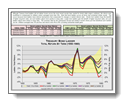Ladder in a Bear
Although Treasury bond ladders did not deliver losses across the most recent secular bear market for bonds (1950–1980; date range is arbitrary), the returns were insufficient to compensate for inflation, which averaged more than 4% for the period. Note that bond ladders across all terms had somewhat similar results. This consistency occurs because bond ladders have internal mechanisms that compensate for changes in market interest rates. Shorter-term ladders forgo the benefits of higher long-term rates, but such ladders adjust more quickly to rising rates. Longer-term ladders gain the benefit of higher long-term rates, but such ladders adjust more slowly to rising rates. The summary data for the subsequent secular bull market in bonds shows just how beneficial such markets can be — inflation averaged near 3%, and thus real returns were 4% to 6%+, providing substantial wealth gains.

